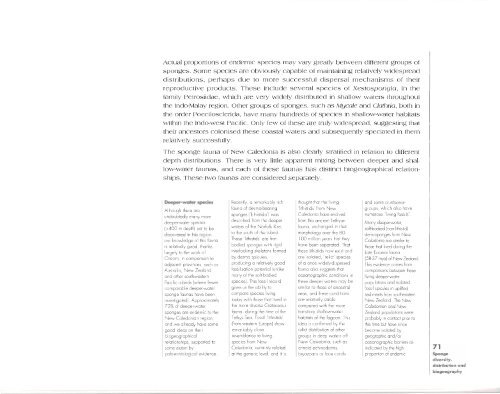Sponges of the New Caledonian lagoon - IRD
Sponges of the New Caledonian lagoon - IRD
Sponges of the New Caledonian lagoon - IRD
Create successful ePaper yourself
Turn your PDF publications into a flip-book with our unique Google optimized e-Paper software.
Actual proportions <strong>of</strong> endemic species may vary greatly between different groups <strong>of</strong><br />
sponges. Some species are obviously capable <strong>of</strong> maintaining relatively widespread<br />
distributions, perhaps due to more successful dispersal mechanisms <strong>of</strong> <strong>the</strong>ir<br />
reproductive products. These include several species <strong>of</strong> xestospongia. in <strong>the</strong><br />
family Petrosiidae. which are very Widely distributed in shallow waters throughout<br />
<strong>the</strong> Indo-Malay region. O<strong>the</strong>r groups <strong>of</strong> sponges. such as Mycale and Clathria. both in<br />
<strong>the</strong> order Poecilosclerida. have many hundreds <strong>of</strong> species in shallow-water habitats<br />
within <strong>the</strong> Indo-west Pacific. Only few <strong>of</strong> <strong>the</strong>se are truly Widespread. suggesting that<br />
<strong>the</strong>ir ancestors colonised <strong>the</strong>se coastal waters and subsequently speciated in <strong>the</strong>m<br />
relatively successfully.<br />
The sponge fauna <strong>of</strong> <strong>New</strong> Caledonia is also clearly stratified in relation to different<br />
depth distributions. There is very little apparent mixing between deeper and shal<br />
low-water faunas. and each <strong>of</strong> <strong>the</strong>se faunas has distinct biogeographical relation<br />
ships. These two faunas are considered separately.<br />
Deeper-water species<br />
Although <strong>the</strong>re ore<br />
undoubtedly mony more<br />
deeper-woter species<br />
(>400 m depthl yet to be<br />
discovered in this region,<br />
our knowledge <strong>of</strong> this founo<br />
is relotively good, thonks<br />
largely to <strong>the</strong> work <strong>of</strong><br />
Orstom, in comparison to<br />
adjacent provinces, such os<br />
Australia, <strong>New</strong> Zealand<br />
and o<strong>the</strong>r southwestern<br />
Pacific islands (where fewer<br />
comparable deeper-water<br />
sponge faunas hove been<br />
investigatedI. ApprOXimately<br />
72% <strong>of</strong> deeper-water<br />
sponges are endemic to <strong>the</strong><br />
<strong>New</strong> <strong>Caledonian</strong> region,<br />
and we already hove some<br />
good ideas on <strong>the</strong>ir<br />
biogeographical<br />
relationships, supported to<br />
some extent by<br />
palaeontological evidence.<br />
Recently, 0 remarkably rich<br />
fauna <strong>of</strong> desma-bearing<br />
sponges l'Lithistida') was<br />
described from <strong>the</strong> deeper<br />
waters <strong>of</strong> <strong>the</strong> Norfolk Rise,<br />
to <strong>the</strong> south <strong>of</strong> <strong>the</strong> island.<br />
These 'Iithistids' are firm'<br />
bodied sponges with rigid<br />
interlocking skeletons formed<br />
by desma spicules,<br />
producing 0 relatively good<br />
fossilisation potentiallunlike<br />
many <strong>of</strong> <strong>the</strong> s<strong>of</strong>t-bodied<br />
speciesl. This fossil record<br />
gives us <strong>the</strong> ability to<br />
compare species living<br />
today with those that lived in<br />
<strong>the</strong> more diverse Cretaceous<br />
fauna, during <strong>the</strong> time <strong>of</strong> <strong>the</strong><br />
Tethys Sea. Fossil 'Iithistids'<br />
(from western Europe) show<br />
remarkably close<br />
resemblance to living<br />
species from <strong>New</strong><br />
Caledonia, certainly related<br />
at <strong>the</strong> generic level, and it is<br />
thought that <strong>the</strong> living<br />
'Iithistids' from <strong>New</strong><br />
Caledonia hove evolved<br />
from this ancient Tethyan<br />
fauna, unchanged in <strong>the</strong>ir<br />
morphology over <strong>the</strong> 80<br />
100 million years that <strong>the</strong>y<br />
hove been separated. That<br />
<strong>the</strong>se lithistids now exist and<br />
are isolated, 'relict' species<br />
<strong>of</strong> 0 once widely-dispersed<br />
founa 0150 suggests that<br />
oceanographic conditions in<br />
<strong>the</strong>se deeper waters may be<br />
similar to those <strong>of</strong> ancestral<br />
seas, and <strong>the</strong>se conditions<br />
are relatively stable<br />
compared with <strong>the</strong> more<br />
transitory shallaw-water<br />
habitats <strong>of</strong> <strong>the</strong> <strong>lagoon</strong>. This<br />
ideo is confirmed by <strong>the</strong><br />
relict distribution <strong>of</strong> o<strong>the</strong>r<br />
groups in deep waters <strong>of</strong>f<br />
<strong>New</strong> Caledonia, such os<br />
crinaid echinoderms,<br />
bryazaans or lace corals<br />
and some crustacean<br />
groups, which also hove<br />
numerous "living fossils"<br />
Many deeper-water,<br />
50ft-bodied [non-lilhislidl<br />
demasponges from <strong>New</strong><br />
CoIedania are similar 10<br />
those that lived during <strong>the</strong><br />
Late Eocene fauna<br />
158-37 mya) <strong>of</strong> <strong>New</strong> Zealand.<br />
This evidence comes from<br />
comparisons between <strong>the</strong>se<br />
living deeper-woter<br />
populatians and isolated<br />
fossil spicules in uplifted<br />
sediments from sou<strong>the</strong>astern<br />
<strong>New</strong> Zealand. The <strong>New</strong><br />
<strong>Caledonian</strong> and <strong>New</strong><br />
Zealand papulations were<br />
probably in contact prior to<br />
this time but hove since<br />
become isolated by<br />
geographiC and/or<br />
oceanographic barriers os<br />
indicated by <strong>the</strong> high<br />
proportion <strong>of</strong> endemiC<br />
71<br />
Sponge<br />
diversity,<br />
distribution and<br />
biogeography

















